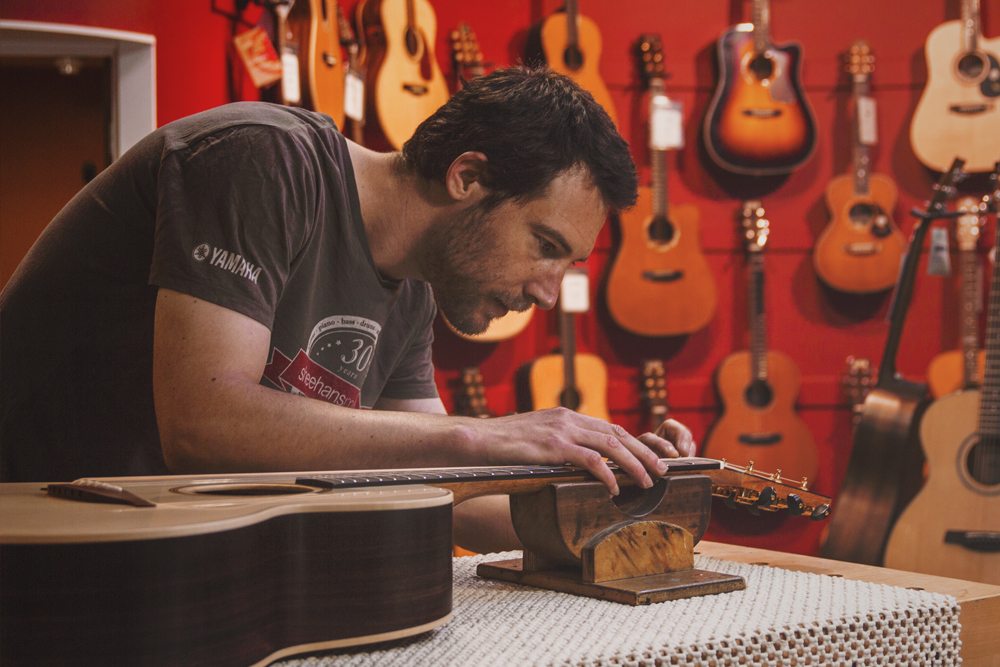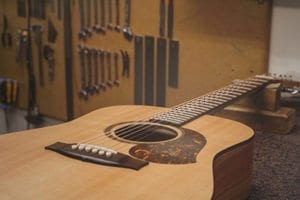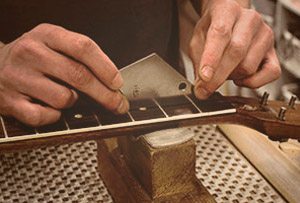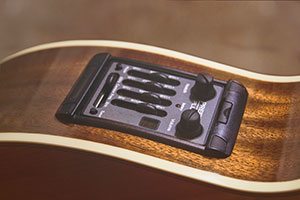How To Set Up An Acoustic Guitar
An Introduction to Audio-visual Guitar Setups
The single most important issue when you are hiring or buying an acoustic guitar is that it is properly set upward!
The video to the left shows a guitar going through a full premier setup, including nut, saddle and fret work.
What Exactly Does 'Setup' Mean?

For an audio-visual guitar to piece of work properly, it is very important that the gap between the strings and the frets (called the 'action') is set correctly. If the strings are too close, they will rattle against the metal frets when they're played and the guitar will audio horrible. If the strings are too far from the frets, the player will take to push down much harder on the strings, which will make the guitar uncomfortable to play and can often curve the notes out of melody.
To become the right gap between the strings and the frets all the mode forth the guitar's neck, several fine adjustments have to be made – these adjustments are known every bit the 'setup'. To gear up an acoustic guitar properly requires specialist tools, accurate measurements, and expert knowledge – so information technology needs to be washed by an experienced guitar technician.
[Back to the Peak]
Why new audio-visual guitars need setting up
In theory, all audio-visual guitars should exist set up perfectly when they leave the factory – however – in our experience, very few of the guitars delivered to our store make it in this condition.
Why? There are several reasons for this:
- Poor manufactory setups – Setting up an audio-visual guitar properly takes skill and fourth dimension, just factory setups (particularly on budget instruments) are washed equally quickly as possible, to keep the manufacturer'south labour costs downward. Oft the manufacturer will cut corners, and sometimes mistakes are made that don't get picked upwardly by the factory's quality command department.
- Moisture / Humidity – wood is a volatile material that expands when it's wet, and contracts when it's dry. Most acoustic guitars are fabricated of several unlike species of forest, with unlike densities and grain patterns, and different degrees of reaction to moisture. If the humidity of the environment in which the guitar is stored changes at whatsoever point, it tin can have a noticeable effect on the setup.
- Transport and storage times – nowadays, most acoustic guitars – particularly budget instruments – are made in the far east, mainly China, South korea, Indonesia and Taiwan. Some are sent past air freight, but most arrive in the UK on cargo ships, after a journey taking several weeks. They then wait in an importer/wholesaler'south warehouse until they are ordered past a shop. During this fourth dimension, the tension of the strings and the truss rod in the neck tin can cause the geometry of the guitar to move effectually, even if the temperature and humidity are kept constant.
So, even if an acoustic guitar was set up perfectly at the factory where information technology was made (and not all of them are), at that place's no guarantee that it volition make it at a shop in the UK in this condition. In our experience, almost all the acoustic guitars that are delivered to our warehouse need some work doing to them before they tin can be hired.

[Back to the Top]
A look at the setup process
For anyone who's curious to know how an acoustic guitar is prepare, here'due south a step past step guide to how we practice information technology.

Before starting any work, we need our repairer's expert eye to check over the guitar carefully to make sure there are no major bug and bug, such as cracks in the wood, or anything that will prevent the guitar from being set up properly.
Over the years we accept seen diverse problems, or bug, that if not picked up on at starting time can lead to expensive repair bills further down the line.
At this stage, whatever musical instrument that doesn't encounter our high standards is sent dorsum to our supplier, who will substitution it for a new ane.

Virtually acoustic guitars are factory-fitted with light gauge (12-53 or 12-54) strings, although some of the high-finish manufacturers, notably Taylor and Collings, now fit medium gauge (13-56) strings as standard. Using a set of micrometers, our repairer measures the string gauge, and makes a annotation of information technology on our set-upwardly tag.
It's besides very important at this stage that the guitar is tuned upwardly to concert pitch, equally the pitch affects the tension of the strings, which in turn affects the geometry of the guitar, especially the curvature of the neck.
If yous are planning on having your guitar set up then deciding on your preferred gauge and even your most used tuning tin can have a begetting on how the guitar is set. Equally dissimilar strings work for unlike things, we are always happy to suggest on this.

In one case the strings are tuned correctly, the repairer can set the curvature of the neck by adjusting the tension of the truss rod – a long metal rod that'due south congenital into the neck backside the fingerboard to counterbalance the tension of the strings.
Loosening the truss rod increases the curvature of the neck, tightening it makes the neck straighter. When set correctly, the neck should accept a very slight concave curve to information technology, which our repairer measures by resting a long, metal straight-edge along the fretboard.

Using a fret rocker, our repairer checks for any points where the rocker is able to rock dorsum and forth – an indication that one or more of the frets is higher than information technology should be. If this is the example, the repairer volition make whatsoever necessary adjustments using a set up of particularly contoured fret files.
The depth of the grooves in the nut (the block of bone or hard plastic at the terminate of the fingerboard) affects the guitar's string height or activity, peculiarly on the frets closest to the nut. If the grooves are left too shallow, the strings will be too high above the first fret, making it very difficult to play sure chords such equally a barred F. If the grooves are cut too deep, the open strings volition catch on the showtime fret when they vibrate and sound like a sitar!
On rare occasions when guitars come in with the grooves cut too deep, our repairer will make a completely new nut from a bare block of bone – well-nigh of the time, though, guitars are shipped from the factory with the grooves cut too shallow, and our repairer uses a special fix of narrow metal files to cut them to the right depth.

The top of the saddle (the strip of bone or hard plastic where the strings bring together the trunk of the guitar) is curved in two directions. Put but, along the longer confront of the saddle, the curvature should correspond to the camber of the fingerboard, and then that when the activeness is fix correctly for the 1st and 6th strings, it's correct for all the other strings too.
A standard acoustic guitar saddle is likewise curved when viewed cease-on, creating a smooth surface for the cord to run across. However, many manufacturers accept now switched to 'compensated' saddles (run across image) with a ridge that alternates between the front end and dorsum edge of the saddle, assuasive for the deviation in string tension between the plain and wound strings, and thus improving the intonation.
Present, nearly all guitar manufacturers use moulded plastic saddles, with the correct profile. Occasionally though, a second manus guitar will need the saddle replacing or re-shaping, peculiarly if there are grooves where the strings take cut into it.
This is the final adjustment to set the gap between strings and frets along the length of the cervix. To practise this our repairer measures the distance of the bass (6th, thickest) and treble (1st, thinnest) strings from the 12th fret. For a practiced, general purpose playing action that suits fingerpicking and strumming styles of playing, the 'action' at the 12th fret should exist a picayune nether 3mm* for the 6th string, and around 2mm for the 1st string.
Because the 12th fret is exactly one-half way along the cord, the repairer will note the amounts by which the action needs to exist raised or lowered for the 1st and sixth strings, and heighten or lower the saddle at the signal where the 1st and 6th strings cross it past double this corporeality. If the saddle needs to be lowered, this tin be done past grinding material away from the base of operations of the saddle. If the saddle needs to be raised, a hardwood shim of the required thickness is fastened to the base.
The repairer must likewise ensure that the base of operations of the saddle is completely flat, specially if the guitar is an electro audio-visual model, as an uneven saddle can lead to bug with the pickup response.
*If the guitar is merely e'er to be used for very light fingerstyle playing, it's possible to set the activity a fraction lower than normal, merely this will mean the strings will rattle if they are ever played hard. On the other hand, some players may prefer a slightly higher activity, for example if the guitar is to be used mainly for slide playing. Either mode, we can adjust the action to suit a player's specific needs.

If the guitar is electro-audio-visual, the pickups need to exist checked to make certain they are working correctly. If there is a problem with certain strings sounding besides loud or soft, our repairer checks the base of the saddle to make certain information technology is completely apartment, and also for any dirt or unevenness in the lesser of the saddle slot. Occasionally the saddle slot needs to be routed out to ensure that it's properly flat, although thankfully this is rarely a problem with modern guitars.
[Dorsum to the Top]
Source: https://musicalinstrumenthire.com/acoustic-guitar-set-ups/

0 Response to "How To Set Up An Acoustic Guitar"
Post a Comment